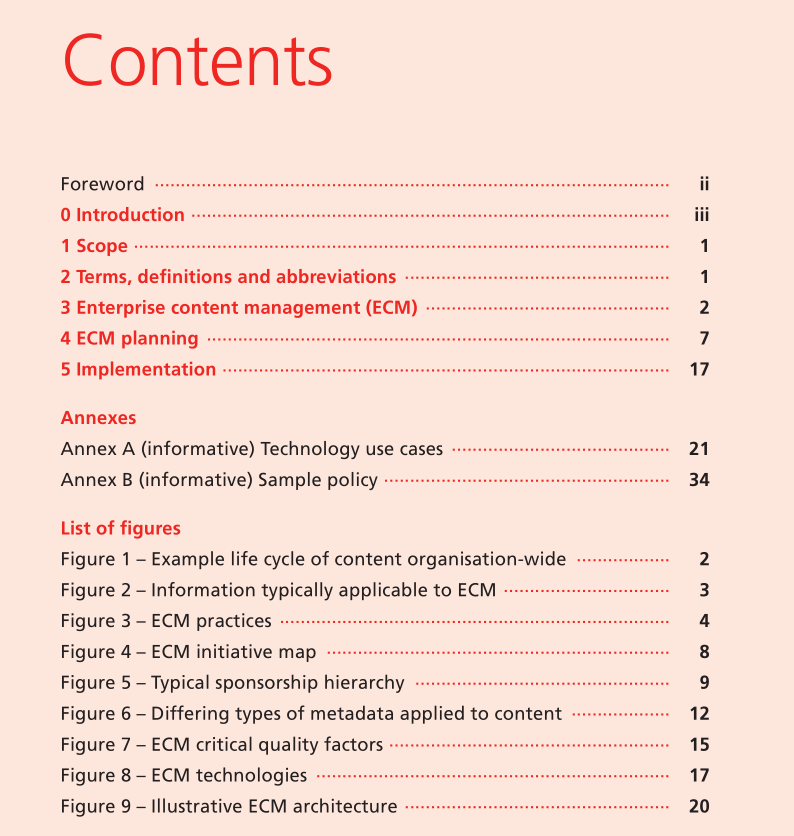PAS 89:2012 pdf download.Enterprise content management – Code of practice
1 Scope
This PAS details good practice for enterprise content management (ECM). It defnes what ECM is and what to consider when embarking on an ECM initiative. It can be used to further an existing initiative or used to develop a new initiative. It is applicable to all those involved in or considering ECM, particularly end user organisations. In particular it is intended for use by project managers, business stakeholder managers, IT managers, record managers and information managers in organisations who are engaged in seeking to establish good use of information organisation-wide. It is not intended to be a technical specifcation, business case, project management methodology, information strategy or service delivery model. This PAS does not provide any particular alignment to specifc industry sectors.
2 Terms, defnitions and abbreviations
For the purposes of this PAS, the following terms and defnitions apply. 2.1 Terms and defnitions 2.1.1 enterprise content management (ECM) framework of practices and technologies that work in an integrated fashion across the organisation to manage information 2.1.2 life cycle stages information goes through from creation to disposition or destruction 2.1.3 metadata set of data that describes and gives information about other data 2.1.4 practices activities and supporting processes for ECM 2.1.5 system collection of ECM technologies 2.1.6 taxonomy managed set of terms 2.1.7 technologies software products which support the application of ECM 2.2 Abbreviations CAD – computer aided design CMIS – content management interoperability services ECM – enterprise content management ECMS – enterprise content management system EDI – electronic data interchange HR – handprint recognition ICR – intelligent character recognition IT – information technology JCR – java content repository KPI – key performance indicator OCR – optical character recognition OMR – optical mark recognition PDF – portable document format RFI – request for information ROI – return on investment SQL – structured query language XML – extensible markup language
3 Enterprise content management (ECM)
3.1 What is ECM? ECM is a framework of practices and technologies that work in an integrated fashion across the organisation to manage information. Those responsible for ECM within the organisation should ensure that they have an understanding of what ECM is and what it is comprised of. NOTE This clause further describes the makeup of ECM and what needs to be understood in regard to ECM when embarking on an ECM initiative.3.2 Organisation-wide ECM should be established organisation-wide for managing content throughout its life cycle. Figure 1 provides an example of the life cycle of content. NOTE Whilst ECM might be established organisation- wide this does not rule out a phased approach being adopted in achieving this goal. In fact such a phased approach can assist in reducing the risk involved in establishing ECM.3.6 Organisational objectives 3.6.1 General Organisational objectives should be identifed and provide the driver for ECM. The organisational objectives should be categorised in one, if not all, of the broad categories detailed in 3.6.2 to 3.6.5. NOTE Whilst the objectives might, one way or another, be implicit with ECM it is not necessarily with a view to creating the “paperless offce”. Paper is best suited as a transient means of capturing and communicating information in an easily accessible form and as long as it is approached in this way it can be integrated into ECM and be of beneft. This correct use of paper can also help with user acceptance and change management. 3.6.2 Operational effciency Consideration should be given as to where the greatest effciency gains could be achieved through establishing ECM. Ineffciency could come in many forms such as duplication of effort, people-intensive processes, poor use of time looking for content, avoidable errors, problems that have arisen and work that has to be done again due to poor content use.
PAS 89:2012 pdf download
